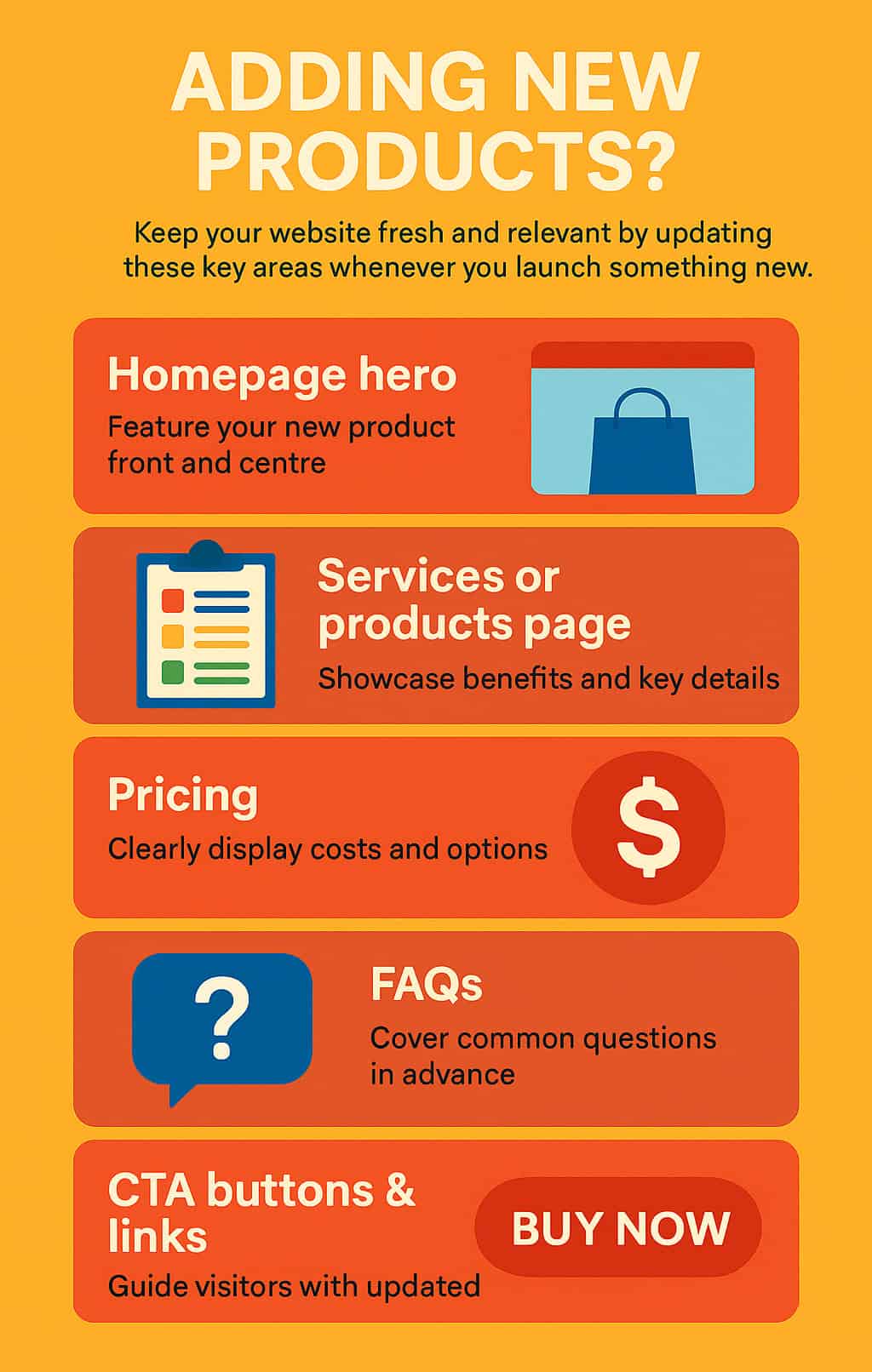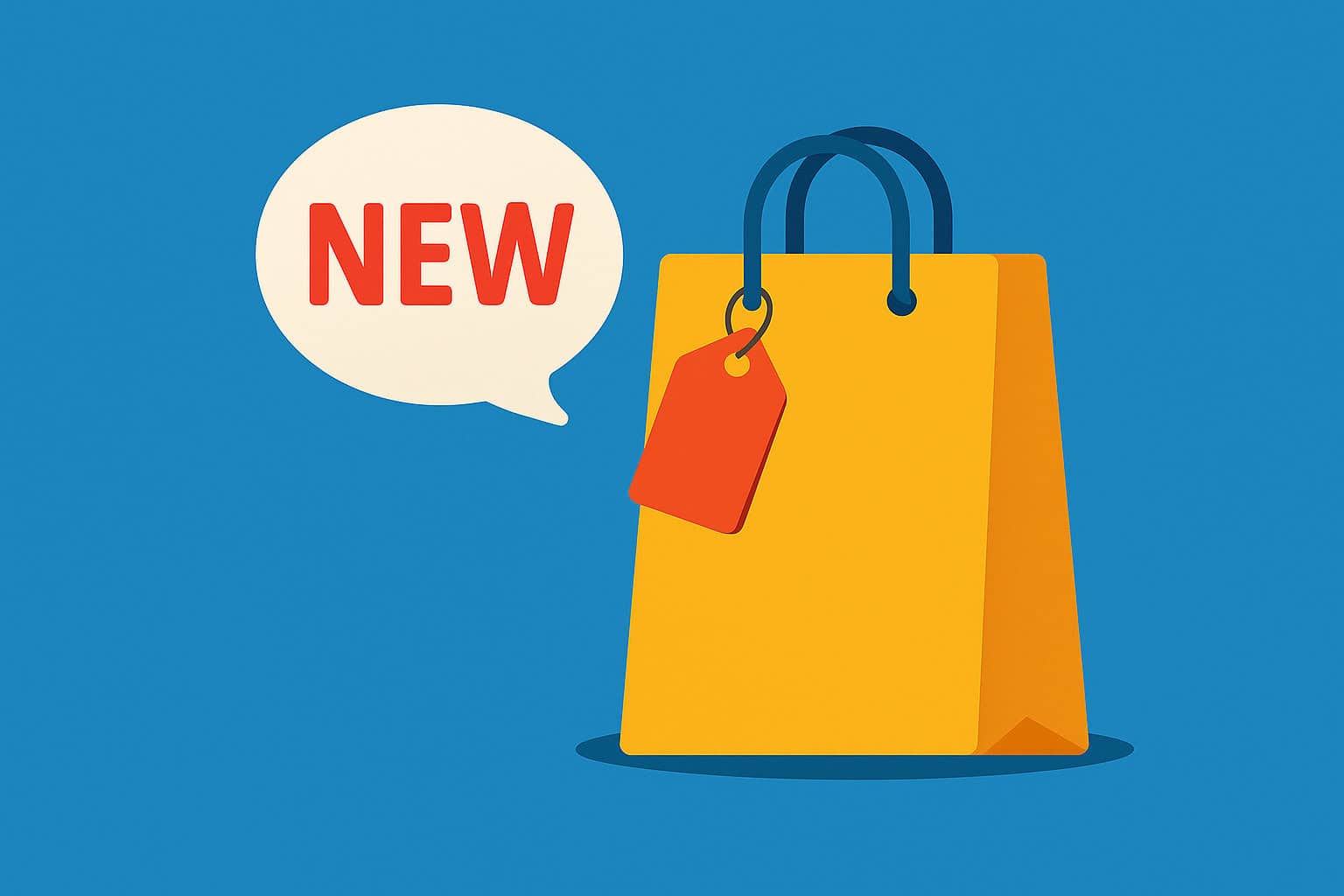Key Takeaways
When adding new products or services to your website, don’t just publish a new page and call it done. For better SEO, a smoother user experience, and more sales, update these 5 key areas:
✅ Homepage hero – Feature your new offering front and centre.
✅ Services or products page – Add a section with benefits and details.
✅ Pricing page – Be clear and transparent about costs and options.
✅ FAQs page – Answer common questions before customers ask.
✅ CTA buttons & links – Guide visitors to take action with updated text.
Bonus: Announce the updates across your social channels to keep your audience informed and engaged.
👉 Let’s Chat if you need help updating your site or getting your new offer in front of the right audience.
Rolling out something new is exciting, but adding new products without updating the rest of your site is like hanging a “Grand Opening” sign on a closed door. Search-engine bots and visitors still see yesterday’s info. Below, I’ll pinpoint the five pages to refresh first, why each matters for SEO and user experience (UX), and easy ways to announce the update across social media.

Homepage Hero: Your Digital Storefront Window.
Why It Matters.
- It’s the #1 landing spot for new and returning visitors.
- Google often pulls homepage snippets for branded searches.
Quick Update Checklist.
- Swap in a headline that mentions your new product/service.
- Add a crisp hero image or video featuring the offer.
- Include a primary CTA button – “See the New Collection Now.”
- Add a brief sub-headline with one or two benefits.
Pro tip: Keep the hero section light (one high-quality AVIF or WebP image) so load times stay fast.
Services (or Products) Page.
What to Do.
- Add a new section to this page, with a clear title, using an “H2” subheading tag (e.g., “Premium Maintenance Plan”).
- Bullet-point benefits, pricing highlights, and a short testimonial if you have one.
- Cross-link to related service pages for internal SEO juice.
UX Tip: Use anchor links in the page’s mini-menu so mobile users can jump straight to the new offer.
Pricing Page: Set Expectations Up Front.
Why It’s Overlooked.
Many owners fear price talk, but transparent pricing builds trust and filters qualified leads.
Small Tweaks, Big Wins.
- Add the new product tier to your comparison table.
- Note any introductory discount (e.g., “Save 10% now during launch month”).
- Highlight “Most Popular” or “New” with a badge so eyes land there first.
SEO bonus: Include long-tail keywords like “digital marketing package pricing” in table sub-text.
FAQ Page: Pre-Empt Repetitive Emails.
How to Update.
- Insert at least two questions about the new product.
- “How does the premium plan differ from standard?”
- “Is there a contract?”
- Keep answers under 75 words for voice-search snippets.
Why It Helps.
- Reduces support queries.
- Improves engagement rate, users stay to read answers.
CTA Buttons & Site-Wide Links: One Clear Path.
Audit Steps.
- Replace old “Learn More” buttons with focused CTAs – “Get the New Pro Package Now.”
- Update sidebar banners or footer promos.
- Ensure every blog-post template has at least one link to the new product page.
Measurement.
Track clicks via Google Analytics Events to see which button placements convert best.
Bonus: Announce on Social Media.
Platform | Action |
X / LinkedIn | Post a teaser graphic linking to the refreshed Services page. |
BlueSky / Pinterest | Pin an infographic or carousel with key features + link back. |
Facebook/Instagram | Share a short reel of the new product in action. |
Fresh social posts drive crawlers and customers to your newly updated pages – double win.
Updating these five pages: Homepage Hero, Services, Pricing, FAQ, and CTAs, keeps your message consistent, boosts search visibility, and guides visitors straight to your new offer.
Want hands-off help refreshing pages and installing faster themes or plugins?
👉 Let’s chat, our team will tune up your site, improve performance, and keep daily backups so you can focus on serving those new customers.
FAQs
I added a new product—why update other pages too?
Because your visitors (and Google) don’t always land on your new product page first. Updating your homepage, services, pricing, FAQs, and buttons ensures they see what’s new no matter where they start.
Can I just post about the new product on social media instead?
Social media is great for getting the word out, but your website is your digital storefront. If your main pages aren’t updated, customers may miss key info, or think it’s outdated.
What’s the most important page to update first?
Start with your homepage and services page, they’re usually the most visited. Then update your pricing page, FAQs, and any buttons or links that lead to the new product.
Do I have to show prices on the website?
Not always, but visitors appreciate clear pricing, even if it’s a range or starting price. It helps them make faster decisions and builds trust.
How do I know if my updates are helping?
You can use free tools like Google Analytics to see if people are visiting your new product page, clicking buttons, or spending more time on updated sections.
Should I also update my blog when I launch a new product?
Yes, if you have one! A short blog post introducing the product can improve SEO and give you more to share on social media.
How often should I review and update my site’s content?
At least every few months, or any time you add a product, change pricing, or run a special offer. Keeping things fresh shows customers your business is active and reliable.

